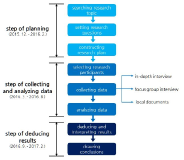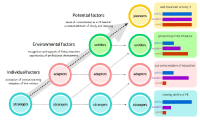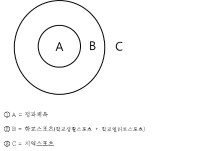PURPOSE This study aimed to analyze the moderating effect of physical fitness on the relationship between abdominal obesity and metabolic syndrome (MetS) in older women. METHODS A total of 190 participants were categorized based on waisthip ratio (WHR) into high (50%) and low (50%) groups, as well as based on Z-score of fitness into high (25%; high fit), moderate (50%; moderate fit), and low (25%; low fit) groups. Logistic regression was used to assess the relative risk of MetS based on abdominal obesity and fitness levels, and moderation analysis using the Process macro was conducted to explore the moderating effect of fitness on the relationship between abdominal obesity and MetS risk factors. RESULTS After adjusting forcovariates, logistic regression showed that high WHR (odds ratio (OR)=2.721, p=0.004) led to a significantly higher risk of MetS compared with low WHR; the high fit group (OR=0.360, p=0.044) had a significantly lower risk of MetS compared wih the low fit group. Moderation analysis revealed that the impact of abdominal obesity on MetS risk factors varied depending on the level of fitness (β=-0.495, p=0.037), and the results remained significant after covariate adjustment (β=-0.458, p=0.049). CONCLUSIONS This study suggests that the risk of MetS from abdominal obesity can be mitigated by higher levels of physical fitness. These findings highlight the need for participation in regular physical activity to maintain a high level of fitness, along with proper nutritional intake, to prevent MetS in older women.
Purpose The purpose of this research is to provide implications for the study of the physical education curriculum in Korea and China by comparatively analyzing the revised high school physical education curriculum in the two countries. Methods Using Bereday(1964)’s four steps of comparison model in education, this study focuses on the format and content of the general high school physical education curricula of Korea and China, each curriculum having been revised respectively in 2015 and 2017. Results First, in terms of format, both countries consider PE a necessity and share similarities in regard to course structure, credit allocation and document format. Nevertheless, though both countries are oriented toward competency-centered education, there are some differences with respect to official education curriculum documents, numbers of subjects and hours of study based on the reality and situation of each country. Second, in terms of content, both countries present various teaching methods and evaluation principles for the sake of acquiring core competence. However, the Korean curriculum prefers to advocate learning of the value of physical activity to achieve core competencies, while the Chinese curriculum prefers to focus on acquiring athletic skills and health knowledge for achieving core competencies. Conclusions After comparing physical education curriculum in both countries, two implications could be obtained. One is that the consistency problem in Korea should be solved between the core competency, the teaching and learning methods and evaluation standards. The other is that, in China, integrated value of physical education should be paid more attention and core competency as well as teaching and learning methods should be considered.

[Purpose] The purpose of this study was to explore the formation process and influential factors of professional identity for the establishment and growth of physical education(PE) teachers majoring in dance. [Methods] Based on the phenomenological research method, data from the interviews, focus group interviews, and local document were collected and analyzed from ten teachers. [Results] First, we explored the process of professional identity formation of PE teachers majoring in dance. It appeared in four stages, 'stranger,' 'adaptation,' 'settler,' and 'pioneer.' Second, we explored the factors of forming the professional identity of the PE teachers majoring in dance. The factors influencing the process of identity formation from the stranger to the adaptation were 'utilization of various training' and 'imitation of their mentor.' The factors influencing the formation process of identity formation from the adaptation to the settler were 'recognition and support of fellow teachers' and ‘opportunity of professional development.’ The factors influencing the process of identity formation from the settler to the pioneer are ‘sense of commitment as a PE teacher,’ ’constant attitude of study and learning.’ [Conclusion] The results suggest that the formation of professional identity of PE teachers majoring in dance goes through a certain stage, and the environment is important as well as the active effort and potential attitude of individual.



Drawing on the studies of implicit ways of teaching (Choi, 2002; Fenstermacher, 1990; Hasen, 2001; Oakeshott, 1989; van Manen, 1991), the aim of this study is to examine the educational effects of indirect teaching behavior (ITB), a new approach of researching teacher behavior, in order to better understand well-rounded education in the field of physical education. An ethnographically informed case study based on participant observation (eight months, 8th grade two co-ed physical education classes) was employed to produce a thick description of the ITB. Participant observation was supported by video recordings of classes, photos of students, questionnaires and interview, and teacher's self-report. Through inductive analysis of the data, we found that ITB had a powerful influence on forming a positive classroom atmosphere in relation to fun, active and moral. The positive atmosphere played a pivotal role in encouraging students' social and moral development including respecting their teacher, cooperating with other friends, learning the intrinsic value of physical education, and reflecting themselves. An understanding of ITB will help expand the way in which educators view teaching methods and studies in physical education beyond the dominant approach to techniques-oriented teaching in that ITB can be seen as essential content for holistic development of students. In this sense, this paper suggested that researchers and teacher educators need to re-examine the power of ITB in regard to teacher's professional competence in physical education and teacher education (PETE). For future research of ITB, it is necessary to explore what and how key personal and social-cultural factors impact teachers' ITB as is currently being conducted in the realm of teaching.
This study was designed to investigate the effects of increment of physical activity for 12 weeks through aerobic exercise training or change from own vehicle to public transportation for commuting on physical fitness, insulin resistance, inflammatory markers, and liver function in middle-aged men. Forty-four subjects, aged 30-50 yrs, were randomly assigned to either one of three groups, i.e., aerobic exercise training group (TR: n=14), change to public transportation group (PT: n=15), or control group (CON: n=15). Subjects in TR performed aerobic exercise for 30 min per sessions, three sessions per week, subjects in PT changed from their own vehicle to public transportation for commuting, and subjects in CON maintained their life patterns during the same intervention period. Physical fitness, insulin resistance, inflammatory markers, and liver function were measured at pre- and post-test, and the data were analyzed by repeated two-way ANOVA. Main results of the present study were as follows: 1) All variables related to physical fitness improved significantly in TR. Right grip strength, standing long jump, side step test, and sit-and-reach improved significantly in PT. 2) Although there were no significant changes in all variables related to insulin resistance, the variables tended to be improved in TR and PT. 3) TNF-α decreased significantly in TR and PT. IL-6 and CRP tended to be improved in TR and PT; however, the changes did not reach statistical significant level. 4) ALT decreased significantly in PT. AST and γ-GT tended to be improved in TR and PT; however, the changes did not reach statistical significant level. It was concluded that the 12 weeks of change to public transportation as well as aerobic exercise training would be beneficial for physical fitness and inflammatory markers. These interventions also would be possible to improve insulin resistance and liver function. The increment of physical activity through change from own vehicle to public transportation was found to be equally beneficial for health promotion compared to aerobic exercise.
PURPOSE This study aimed to explore and analyze research impact of Korean ’Kinesiology’ studies, especially in the aspects of international research impact gauged by the citation counts from Scopus bibliometric database. This study contributes to relevant literature in that it is the first endeavour to evaluate the pattern about how the entire Korean ’Kinesiology’ articles have been cited in international articles. METHODS TTwo types of sample articles were collected in this paper. Firstly, 19,867 target articles published in 23 KCI-accredited Korean ’Kinesiology’ related journals from 2001 to 2015. For the Korean target articles, secondly, international citing articles that took advantage of target articles as references were collected from Elsevier’s Scopus database separately. RESULTS As a result, just 5% of the target articles were cited at least once for five years after publication. The topics of top cited research topics include ‘exercise’, ‘physical activity,’ ‘Alzheimer’s disease, ‘ ’body composition’ and ‘insulin resistance’. Besides, the Korean 'Kinesiology’ articles were the most influential to articles about ‘Medicine,’ ‘Health Professions,’ ‘Multidisciplinary,’ ‘Social Sciences,’ and ‘Nursing’. CONCLUSIONS This study showed that one Korean ’Kinesiology’ article was cited 0.09 times on an average in international Scopus-indexed articles. Considering that the average number of citations in domestic articles is 5.6 times, the international citations of Korean ’Kinesiology’ research still have much room for growth. However, this study confirmed that the scope of the international impact is not limited to a few countries, but is spreading to various countries, and its impact has been growing in recent years.
Purpose The present study compared physical fitness, metabolic syndrome risk factors, and resting metabolic rate (RMR) according to body mass index (BMI) and percent body fat (%BF) in 20s females. Methods Fifty-one women in their 20s were recruited and assigned into three groups, i.e., normal group (n=18), normal weight obesity (NWO) group (n=18), and obesity group (n=15) according to BMI and %BF. Physical fitness, metabolic syndrome risk factors, and RMR were measured and compared among three groups. Results Main results were as follows: 1) Physical fitness were not significantly different among three groups. 2) Regarding 1-RM, arm curl and leg extension were significantly lower in normal group and NWO group than obesity group. Leg press was significantly lower in normal group than obesity group. 3) Regarding metabolic syndrome risk factors, there were significant differences in waist circumference, ordering from low to high such as normal, NWO, and obesity groups. Systolic blood pressure and diastolic blood pressure were significantly lower in normal group and NWO group than obesity group, while HDL-C was significantly higher in normal group than NWO group and obesity group. 4) Regarding RMR, absolute values of RMR such as VO2(㎖·min-1), RMR (Kcal·min-1), RMR (KJ·min-1), and RMR (Kcal·day-1) were significantly lower in normal group and NWO group than obesity group. On the other hand, relative value of RMR such as RMR (KJ·kg-1FW·h-1) was significantly higher in normal group than NWO group and obesity group. Conclusions It was concluded that obese women showed increased risk of metabolic syndrome and low relative RMR level, and NWO had similar problems. Active health management through physical activity and dietary control should be committed to NWO individuals because the NWO has possibility of high risk of metabolic syndrome and reduction of metabolic rate from 20s even though there was no problem in their external appearance.
[Purpose] The present study attempted to verify the effectiveness of an early childhood physical health improvement program (subsequently in the present study, KICCE Early Childhood Health Improvement Program) developed in Korea by modifying and improving the Mission-X: Train Like an Astronaut program developed by NASA to be suitable for children of ages 4 and 5. [Methods] The subjects in the study were 679 children at 7 facilities in Seongnam city, Osan city, and Yongin city, of which 4 were daycares and 3 were kindergartens. The participant group consisted of 339 children, and the control group consisted of 340 children. The program consisted of total 24 activities 3 times a week over 8 weeks, of which 8 activities were related to nutrition and 16 activities were related to physical activity, and in the 9th and 10th weeks, the 16 physical activities were reconfigured and performed 3 times a week. Physical parameters and related fitness parameters were measured before and after the program, and an ANCOVA analysis was performed in which descriptive statistics and scores before the program were the covariate variables. [Results] The results show that first, growth statuses of participant children were in the upper middle section of the distribution, and second, of the 6 fitness developments, flexibility, balance, and quickness were improved, and in most areas, boys and below-normal-BMI group showed beneficial effects. [Conclusion] Thus, KICCE Early Childhood Health Improvement Program is conclusively proven to be effective for early-childhood physical development.
PURPOSE The purpose of this study was to investigate the effects of an 8-week online yoga training on body composition, muscle activity, flexibility, and balance in males (n=7) and females (n=15). METHODS Twenty-two participants were recruited and divided into two groups (Exercise group, n=11 and control group, n=11). All participants had two visits. During the visits, body composition, muscle activity for forward and back-bending poses, flexibility for sitting-forward and back-bending poses, and balance for one-leg standing were determined. After 8-week yoga training, all measurements were re-performed. An independent t-test was performed to determine the difference between the exercise and control groups. A two-way repeated measures of ANOVA was used to assess the interaction effects (group*time). All values were represented as mean ± standard deviation. An α level was set at 0.05 for all analyses. RESULTS First, the height significantly increased (F=16.573, p=0.001) and body fat mass (F=7.109, p=0.015) and body fat percent (F=7.667, p=0.012) were significantly decreased after the 8-week online yoga training. Second, the muscle activity for vatus lateralis doing a back-bending pose (F=6.140, p=0.022) significantly increased after the 8-week online yoga training. Third, the flexibility on sitting-forward bending pose (F=4.661, p=0.043) and back-bending pose (F=11.650, p=0.003) were statistically increased after the 8-week online yoga training. Lastly, balance on the Center Of Pressure (COP) X (F=5.769, p=0.026) and the Center Of Pressure (COP) Y (F=4.365, p=0.05) significantly increased after the 8-week online yoga training. CONCLUSIONS This study will provide scientific evidence on improving exercise programs using online yoga training on physical activity.

Purpose and Methods The purpose of this study is to clarify the concepts of ‘youth sport policy’ and policy areas as an alternative to school physical education concept and to provide a core conceptual framework for the development and implementation of youth sports policy in the future. Results The notion of youth sport policy is a process of seeking rational decision-making and optimal alternatives to solve the social problems associated with sports participation of youth in elementary school(aged 6 years) to high school(aged 18 years). The concept of 'youth sport' can reflect modern culture rather than 'school physical education' and it can be seen as more future oriented for lifelong participation in sports. The areas of youth sport policy are classified into physical education, school sport, and community sport. Physical education refer to the physical education classes operated by the Ministry of Education, and the school sport refers to the sports activities that take place throughout the school. Community sport is sports activities that are carried out outside the school by the choice of youth, which is the area where cooperation between the public sector and the private sector is needed. Conclusion In conclusion, healthy and active life for youth is required to establish cooperative governance of related organizations in order to ensure proper linkage between youth sport policy areas. Through this, it is necessary to solve the social problems of youth and promote their lifelong enjoyment of sport more consistently, efficiently and effectively.

